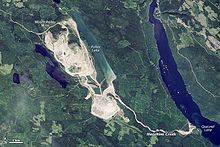Mount Polley Dam
The Mount Polley Dam breach occurred on August 4, 2014 in the Cariboo region of British Columbia , Canada. Due to a breach in the dam, the sedimentation basin (around 25 million cubic meters of water and spoil sludge and other eroded material) of the Mount Polley copper and gold mine, owned by the Canadian mining company Imperial Metals, emptied into Lake Polley and from there into Hazeltine Creek , Quesnel Lake , Quesnel River and Fraser River .
As a result, a local emergency was declared temporarily, the use of drinking water and salmon fishing restricted. The examination of salmon in Quesnel and Polley Lake after the accident revealed increased levels of selenium in the liver and ovaries, above the official limit for consumption, but according to the British Columbia government harmless and similarly high selenium values would also have been in places before Disaster found in 2013. The concentrations of arsenic, copper, manganese and zinc were also slightly increased compared to populations in other lakes in the province, but within the limits for consumption. The newly added metal content, however, still represents an unforeseeable potential danger for the fish population and fauna in Lake Quesnel.
As ultimate cause of the spill is made a layer of glacial Seetone not recognized in the original soil investigation (Glacial lacustrine clays, upper GLU ) between two boulder clay layers in the foundation of the dam from. Instead of a desired safety factor against slope slippage of 1.3, the undrained shear strength of the GLU layer resulted in a value of only 1.02 to 1.04. The experts compared this to a loaded firearm . For cost reasons, the embankment was also made steeper than originally planned and the dump was filled to capacity. In 2010, when the dam was raised, a 10 m long crack appeared and the piezometers for measuring the water pressure in the dam may have been incorrectly placed (the last reading on August 2nd did not show any increased values). The government, which did not carry out any inspections of the dam from 2009 to 2011, was exonerated because it was a hidden defect and no signs (such as cracks, increased water pressure inside the dam) indicated the danger even shortly before the dam broke. The expert for the final report on the causes was, among others, the well-known civil engineer for geotechnics, Norbert R. Morgenstern . A further elevation of the dam was planned shortly before the dam burst. According to the investigation report, the proposed reinforcements prevented the dam from breaking.
literature
- Ellen Petticrew et al. a .: The impact of a catastrophic mine tailings impoundment spill into one of North America's largest fjord lakes: Quesnel Lake, British Columbia, Canada, Geophysical Research Letters, Volume 42, 2015, pp. 3347-3355, online
Web links
- Mount Polley Review Panel
- Mount Polley mine tailings spill: Imperial Metals could face $ 1M fine , CBC News, August 6, 2014
Individual evidence
- ↑ Mount Polley spill: Testing finds elevated selenium in fish, CBC , August 22, 2014
- ↑ Petticrew et al. a. Geophys. Res.Lett., Volume 42, 2015, p. 3355 (abstract)
- ↑ Final report from 2015 (see web links), p. 106
Coordinates: 52 ° 30 ′ 48.4 " N , 121 ° 35 ′ 46.7" W.

